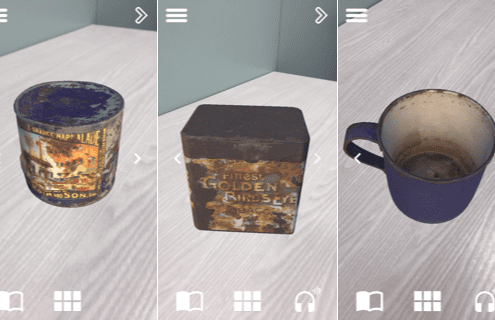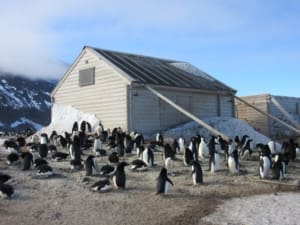Bring the world’s most famous fruitcake into your home
The world’s most famous fruitcake, a bone toothbrush and leather boots are among an eclectic mix of Antarctic artefacts that can now be viewed by people anywhere using augmented reality.
The Antarctic 3D Artefacts section of the Antarctic Heritage Trust Augmented Reality (AR) app brings six items from the first hut built in Antarctica to life in 3D. These objects were left behind by Carsten Borchgrevink’s 1898–1900 British Antarctic Expedition and the Northern Party of Robert Falcon Scott’s Terra Nova expedition in the huts at Cape Adare, Antarctica, and subsequently conserved by Antarctic Heritage Trust’s international team of experts.
Borchgrevink’s Southern Cross expedition began the age of Antarctic exploration, paving the way for Scott, Amundsen, Shackleton and others.
The app enables users to look through their smart device and see the artefacts in 3D right in front of them. They can rotate the item and lean in for a closer look while listening to commentary about why it was important to the expedition.
Bonus content such as videos, photo galleries and blogs can also be accessed that share interesting stories of the early explorers’ expeditions and the Trust’s conservation work at site today.
Download the app for free from Google Play or the App Store.
The application is only available on surface tracking Augmented Reality compatible devices, visit our store pages on your device to see if your device is compatible.
Schools can ask their IT team to get the app via Apple School Manager and mobile device management for free.
Watch our video about how to use the app
A Unique Cold-climate Conservation Achievement
The huts at Cape Adare are currently being conserved by the Antarctic Heritage Trust and are the only example of humanity’s first building on any continent.
Cape Adare, an exposed peninsula on the edge of the continent, is the site of the world’s largest Adelie Penguin colony and infamous for its wind and harsh weather.
Objects from the huts were brought up from the ice under government permit in 2016 by the Antarctic Heritage Trust as part of the Trust’s ongoing work to conserve, share and encourage the spirit of Antarctic exploration. Under the government permit required to remove the items from Antarctica, they must be returned to the huts following conservation. The collection spans a range of objects including a century-old fruit cake, tools and clothing worn by the explorers.
Over approximately 12 months in 2016–17, an international team of conservators used a lab at Canterbury Museum to conserve the artefacts. They have been in secured cold storage since that time and will return to Cape Adare permanently once the Trust has finished conserving the Cape Adare huts.
How was the app created?
Technology to bring Antarctic Artefacts within Reach
While in New Zealand for conservation, a selection of items were scanned using photogrammetry. This uses high-resolution digital photographs taken from multiple perspectives.
Antarctic Heritage Trust partnered with Australian-based Tim Handfield (Handfield & Bell Digitising Consultants) for photography and scanning and Trevor Coates (Leapfrog Strategic Communications) for 3D rendering and model refinement.
By analysing the photographs and identifying corresponding points on the object’s surface from different camera positions; the photogrammetry software calculates the position of each point in 3D to create a point cloud and 3D mesh. Finally, it creates a texture map, selectively projecting the photographic images to fill the 3D surface with colour information.
App users can project a 3D rendering of each object onto a surface in front of them, and then view it from all angles, including above.
“It was a privilege to be entrusted with the 3D scanning of these amazing heritage artefacts and to see the resulting virtual objects in the AHT augmented reality app,” said Tim Handfield.
The Trust worked with New Zealand company, Staples VR, to develop the augmented reality app. Aliesha Staples, CEO of Staples VR said, “Being able to bring Antarctica to the world using emerging technology such as Augmented Reality in a photorealistic way makes this project not only technically challenging but incredibly important to do right. Using our photogrammetry processes to develop the scans Tim captures has been a privilege as we know how few people get to see these artefacts and we have been able to bring these digitally to the world in the most real way.”






